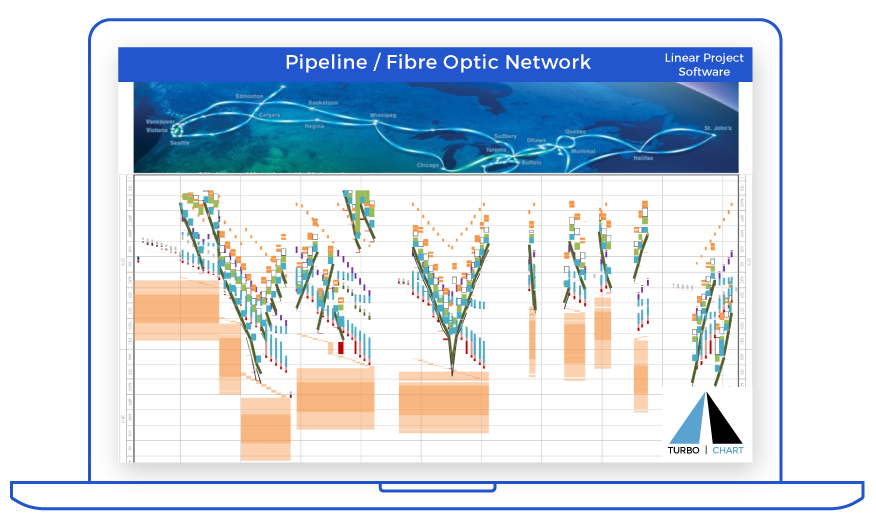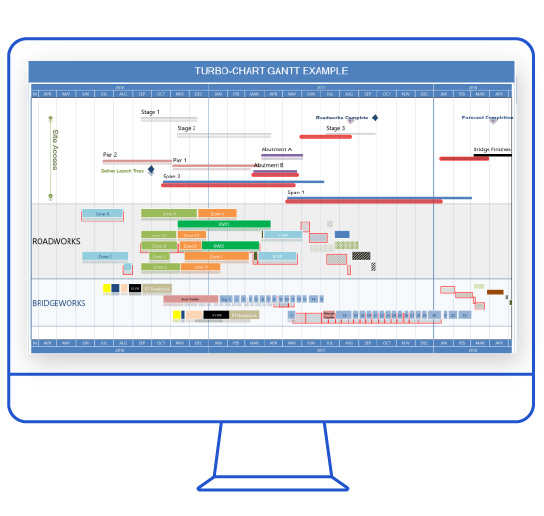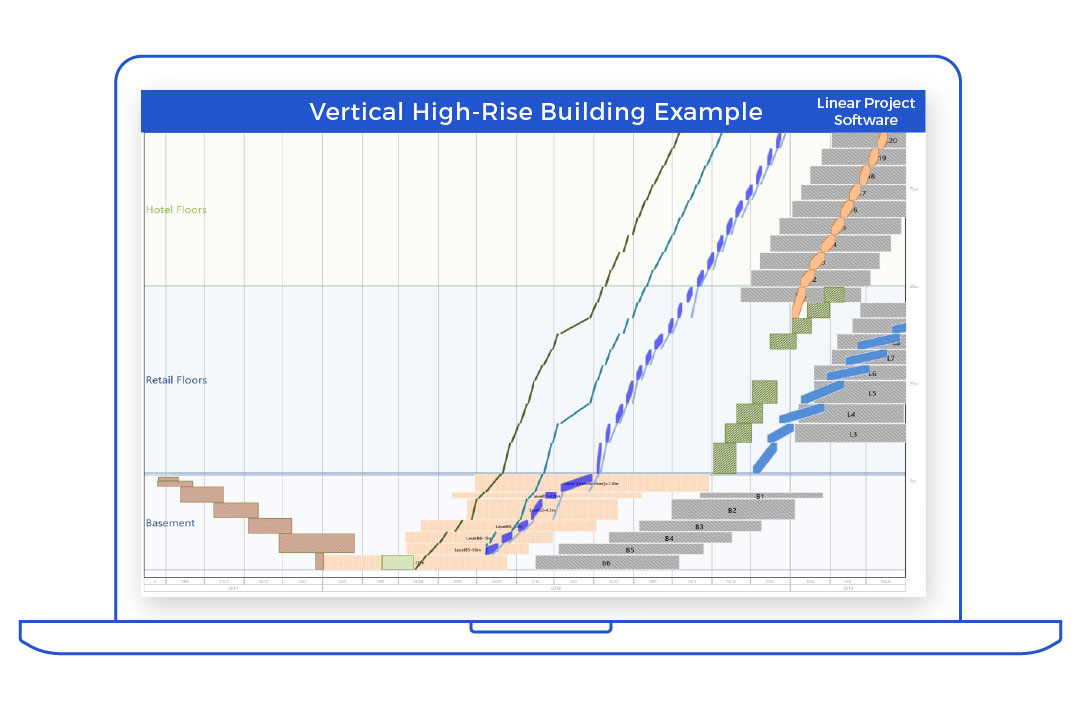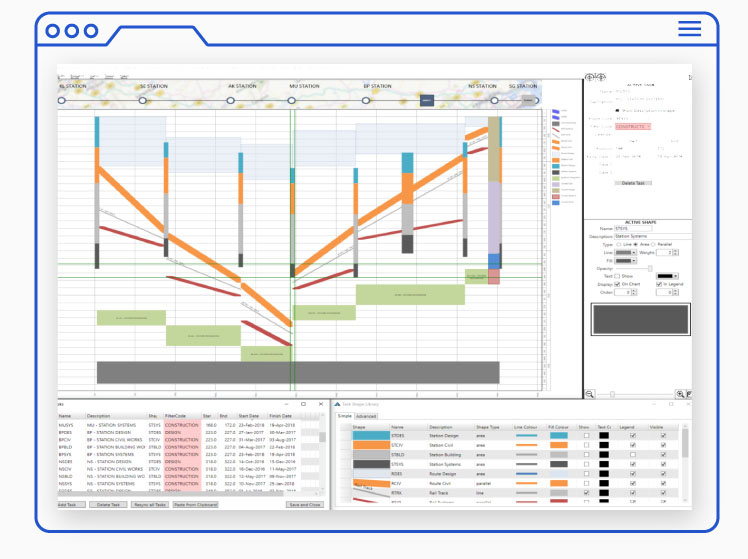Tilos Schedule

Time Location System
Across the construction management, project controls and planning/scheduling disciplines for linear projects, Tilos (the name is a blended word from TIme LOcation System) has become a term synonymous with linear scheduling. In fact, often Tilos is (mistakenly) considered to be the only option when Linear Scheduling or Time Location Charting is required.
Our anecdotal evidence is that the vast majority of users of Tilos, only require the latter Time Location charting functionality, but are required to purchase, be trained in and use all the other features of Tilos they do not require.
So Is
TILOS LINEAR SCHEDULING?
The answer is yes and no, as it’s dependent on what the users’ interpretation of Linear Scheduling is. There are in practice, broadly, three different interpretations of Linear Scheduling:
- The first is simply the generation of Linear Schedules (or Time Location Charts) from other scheduling data, typically from traditional CPM data
- The second is the manipulation of tasks upon the chart, to regenerate dates of other tasks. Tilos falls into this category, offering the ability to edit task duration and relationships in the Time Location chart format and calculate the result using a CPM model that uses lags to maintain distance offsets.
- The third is true Linear Scheduling for linear projects, that relies solely on the Linear Schedule to determine activity paths, longest paths and driving activities along those paths. This is analogous to the forward and backward pass of traditional CPM scheduling. Tilos does not offer this and our research suggests that there is no commercially available product capable of this at the time of writing.


LINEAR SCHEDULING TOOL
So, while Tilos is capable of 1. and 2. above, there is an automatic association that any project requiring Linear Schedules, requires a linear scheduling tool (Linear Scheduling Software), of which Tilos offers the required features.Turbo Chart only offers the functionality of 1. above albeit with greater ease-of-use than Tilos. While we do not promote Turbo-Chart to be a scheduling tool (as there is no scheduling engine or ability to re-calculate task dates), for many users the ability to generate the linear schedules will be just enough to call Turbo-Chart a Linear Scheduling tool. As the process of generating the charts from a CPM tool is very quick using Turbo-Chart, the combination of updating the CPM schedule, and reflecting the update in the linear schedule format, will allow users to use their existing scheduling tool also for linear scheduling purposes.
So What is a Tilos Schedule?
Turbo-Chart vs Tilos Outputs
Tilos Schedule?
Referring to a Linear Schedule/Time Location chart as a “Tilos Schedule” is akin to calling a Gantt chart a “Primavera Schedule”. We have heard from Turbo-Chart customers, that upon being shown a Turbo-Chart output, have been asked “Is that a Tilos schedule?” a good indicator of the confusion surrounding the topic. This confusion is often due to the fact that there is a lack of awareness of methods available to produce Linear Schedules and Time Location charts, with the mistaken belief that Tilos is the only tool capable of producing the desired output. While we at Turbo-Chart would be glad to have the term “Turbo-Chart Schedule” become commonplace, as practitioners in the industry, we advocate the use of terms that are defined by method, processes and principles rather than by any specific toolset.
See Tilos Training.
Integrated Master Schedule (IMS)
Another consideration for the term “Tilos Schedule” is this – on most typical projects, it’s rare that the project schedule only consists of the linear elements. In the context of the overall project, often an Integrated Master Schedule (IMS) will include many non-linear elements as Approvals, Design, Procurement, Testing and Commissioning. The linear elements, typically for construction, may be extracted from the source of the IMS, say Primavera P6, and then imported into Tilos for modification.
This modification, being down in isolation of the overall IMS, results in a “Tilos Schedule” that results in either:
- An independent Tilos Schedule that may not be aligned with the IMS and evolves on its own course, removed from the effects of the other project tasks in the IMS, or
- Requires significant effort in integrating back into the IMS, and validation that the modification is still aligned with the most current state of the IMS.
Changes Instantly Reflected
Using Turbo-Chart, both of those issues are avoided, as Turbo-Chart’s workflow enables the Linear elements of the project to remain within the IMS, in the preferred scheduling tool by the users. Changes to the IMS can be instantly reflected in the Linear Schedules/Time Location charts generated using Turbo-Chart, with the assurance that wider relationships to and from the IMS are being adhered to.
Updates as part of the reporting process
As the IMS is updated on a regular basis, as per the projects reporting timetable, the process of producing an updated Linear Schedule/Time Location chart in Turbo-Chart can also be easily undertaken as part of the reporting process. We hear from many Tilos users that producing updates of their schedule can be a time-consuming process, often requiring a Tilos timetable of the days required to update.

